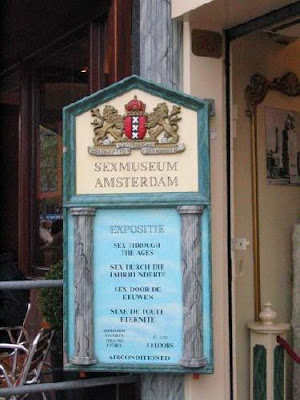Continue from
here and
hereAn oasis of tranquility,
Begijnhof is cluster of small homes around a garden courtyard. The Begijnhof was not a convent, but a cloister founded in 1346 for pious lay women, begijnen, who were involved in religious and charitable work. It was an option for women who lived the religious life without taking monastic vows. The last begijn died in 1971. The 47 homes are currently being occupied by senior citizens. At the garden's edge lies the
Engelse Kerk (English Church). Despite its name, this church, built in 1607 and enlarged in 1665, was actually used by Scottish Presbyterians. Across the street is the
Maagdenhuis, the University of Amsterdam's main downtown building.
The Begijnhof
Maagdenhuis
From Begijnhof, walk through the Schuttersgalerij (Civic Guards Gallery), a narrow, two-story sky-lit passageway that leads to the Amsterdam Historisch Museum (Amsterdam History Museum). This walkway is bedecked with 15 enormous 17th-century paintings of the Amsterdam Civic Guards. The Amsterdam Historisch Museum is housed in the restored 17th-century former Burger Weeshuis (City Orphanage). Gallery by gallery, century by century, the history of how a small fishing village founded around 1200 became a major sea power and trading center is told. The focus is on the city's 17th-century Golden Age, when Amsterdam was the world's wealthiest city, and some of the most interesting exhibits are of the trades that made it rich.
Two of Amsterdam's most famous museums, the Rijksmuseum and the van Gogh Museum, are located around Museumplein, a big square just south of the old center. The country's premier museum, the Rijksmuseum, in a palatial 19th century building, contains the world's largest collection of paintings by Dutch artists from the 15th – 19th centuries, including the most famous of all, Rembrandt's The Night Watch. Other artists represented at the Rijksmuseum include Van Ruisdael, van Heemskerck, Frans Hals, Paulus Potter, Jan Steen, Vermeer, de Hooch, Terborch, and Gerard Dou. In addition, the museum exhibits fine pieces of antique Delftware and silver. Two rare furnished 17th-century dollhouses are also on display, bringing the Dutch Golden Age to life. The dollhouses' former owners commissioned craftsmen to copy objects and ornaments, and the contents are exactly as they were in those days, only in miniature. Tiny seashells occupy a display cabinet. The tapestry room walls are covered with silk, the ceiling and mantelpiece are painstakingly painted, and Italian marble paves the hall floor. Silver spoons rest on the dining table and the family initials are embroidered on the napkins. There are even pins stuck in pincushions.

Top left: The Rijkmuseum; top right: a model dollhouse; bottom: Van Gogh Museum
More than 200 paintings by Vincent van Gogh (1853-90), along with nearly every sketch, print, etching, and piece of correspondence the artist ever produced have been housed in the Van Gogh Museum since it opened in 1973. Van Gogh's sister-in-law and a namesake nephew presented the collection to Holland with the provision that the canvases not leave Vincent's native land. One can trace this great artist's artistic and psychological development - or decline – by viewing the paintings displayed in chronological order according to the seven distinct periods and places of residence that defined his short career.
He painted for only 10 years and was on the threshold of success when he committed suicide at age 37. Only one of van Gogh's paintings sold during his lifetime, but he did give others out to pay for food, drink, and lodgings. The Potato Eaters (1885) was van Gogh's anxious and sensitive first masterpiece. Dark and crudely painted, it depicts a group of Dutch peasants gathered around the table for their evening meal after a long day of manual labor, impressing upon the viewer a sense of the hard, rough conditions of their lives. One particularly splendid wall on the second floor has 18 paintings produced during a 2-year period in the south of France, generally considered to be his artistic high point. It's a symphony of colors and contrasts that includes the famous Sunflowers. The ominous Wheatfield with Crows, the vaguely threatening painting of black crows rising from a waving cornfield, was one of his last paintings and one can almost feel the mounting inner pain the artist was finally unable to bear.
Amsterdam has more than 50 outdoor markets every week. Some are permanent or semipermanent, and others just passing through. Two which I managed to visit are the floating
Bloemenmarkt (Flower Market) and the
Albert Cuyp Markt, Amsterdam's busiest and liveliest market with lots of multicultural food and general goods.




 The village is crisscrossed by canals and paths that cross the water on bridges. There are four different kinds of big industrial windmills here, lined up along the Zaan shore. From south to north from the boat dock, these are Mosterdmolen De Huisman, where the renowned Zaanse mustard is produced; a sawmill, Houtzaagmolen De Gekroonde Poelenburg; Werfmolen De Kat, specialized in producing paint; and two mills that produce vegetable oil, Oliemolen De Zoeker and Oliemolen De Bonte Hen. These are among the dozen out of more than 500 windmills by the end of the 17th centuty that have survived intact in the Zaanstreek.
The village is crisscrossed by canals and paths that cross the water on bridges. There are four different kinds of big industrial windmills here, lined up along the Zaan shore. From south to north from the boat dock, these are Mosterdmolen De Huisman, where the renowned Zaanse mustard is produced; a sawmill, Houtzaagmolen De Gekroonde Poelenburg; Werfmolen De Kat, specialized in producing paint; and two mills that produce vegetable oil, Oliemolen De Zoeker and Oliemolen De Bonte Hen. These are among the dozen out of more than 500 windmills by the end of the 17th centuty that have survived intact in the Zaanstreek.  (to be continued…)
(to be continued…)










 On Westermarkt is the world's first-ever monument to the gays and lesbians killed during World War II and persecuted through the ages. The Homomonument consists of three pink triangular granite blocks (the color and shape of the badge the Nazis forced homosexuals to wear), that together form a larger triangular outline. One block, symbolizing the future, points to the Keizersgracht canal; a second, at ground level, points toward the nearby Anne Frank House; the third, a kind of plinth, points toward the offices of COC, a gay political organization.
On Westermarkt is the world's first-ever monument to the gays and lesbians killed during World War II and persecuted through the ages. The Homomonument consists of three pink triangular granite blocks (the color and shape of the badge the Nazis forced homosexuals to wear), that together form a larger triangular outline. One block, symbolizing the future, points to the Keizersgracht canal; a second, at ground level, points toward the nearby Anne Frank House; the third, a kind of plinth, points toward the offices of COC, a gay political organization. (to be continued…)
(to be continued…)






 She is drinking a lot of milk these days. Previously, she sometimes can't even finish 4oz but she's now drinking 5 – 6oz each time, and more frequently at that. Her record was taking 10oz at one going which is a big deal for her. Oh, she's completely weaned off breastfeeding but will sometimes suck for a split second before she smiles and moves away. And since she now takes a bottle of milk before sleeping, she rarely wakes up in the middle of the night. So mummy finally regains her uninterrupted sleep.
She is drinking a lot of milk these days. Previously, she sometimes can't even finish 4oz but she's now drinking 5 – 6oz each time, and more frequently at that. Her record was taking 10oz at one going which is a big deal for her. Oh, she's completely weaned off breastfeeding but will sometimes suck for a split second before she smiles and moves away. And since she now takes a bottle of milk before sleeping, she rarely wakes up in the middle of the night. So mummy finally regains her uninterrupted sleep.



 Diabetes has a unique impact on children and their families. The daily life of children is disrupted by the need to monitor blood glucose levels, take medication, and balance the effect of activity and food. Diabetes can interfere with the normal developmental tasks of childhood and adolescence, which include succeeding in school and transitioning to adulthood. This year's campaign aims to raise awareness of the rising prevalence of both type 1 and type 2 diabetes in children and adolescents, as early diagnosis and early education are crucial to reducing complications and saving lives. Hop to the
Diabetes has a unique impact on children and their families. The daily life of children is disrupted by the need to monitor blood glucose levels, take medication, and balance the effect of activity and food. Diabetes can interfere with the normal developmental tasks of childhood and adolescence, which include succeeding in school and transitioning to adulthood. This year's campaign aims to raise awareness of the rising prevalence of both type 1 and type 2 diabetes in children and adolescents, as early diagnosis and early education are crucial to reducing complications and saving lives. Hop to the 








